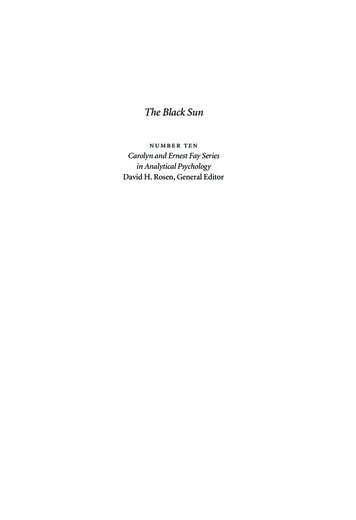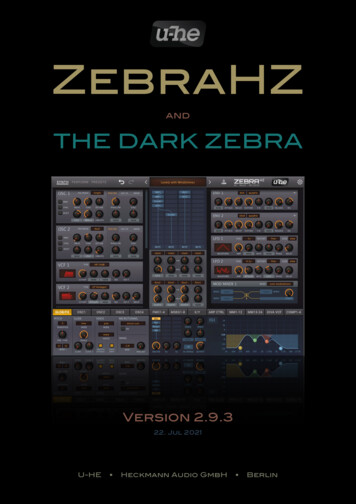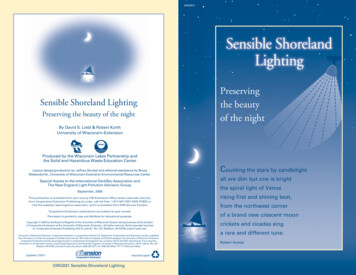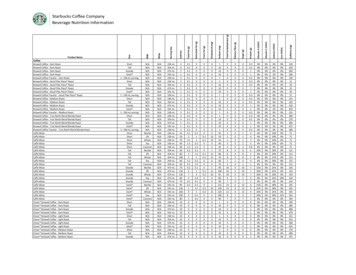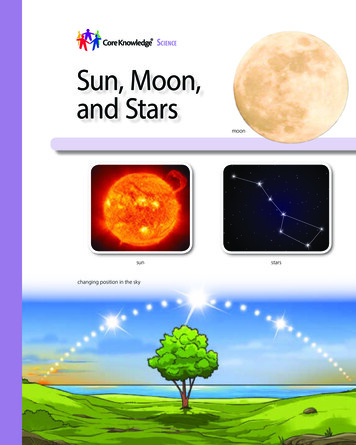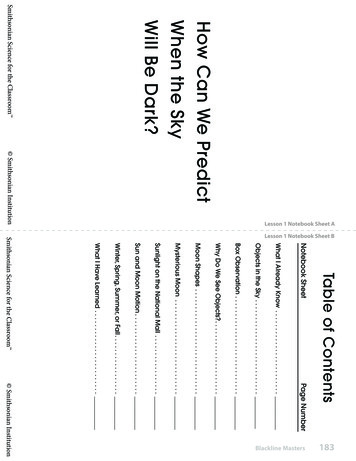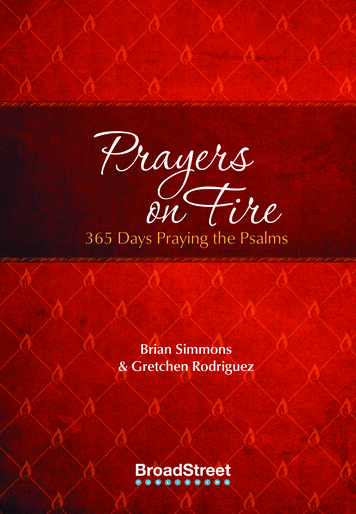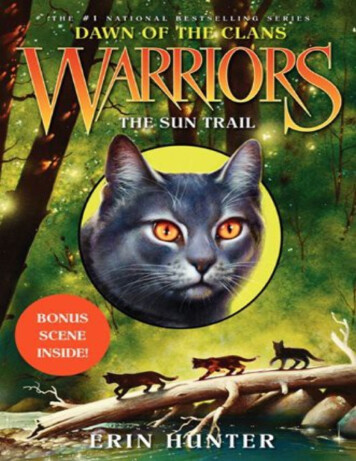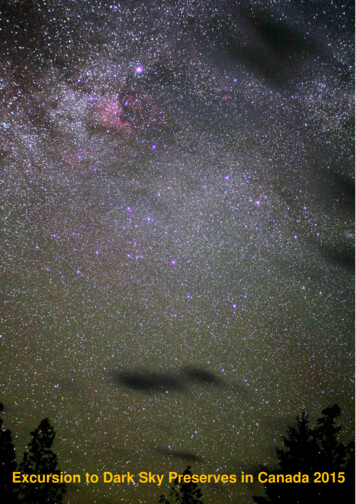
Transcription
Excursion to Dark Sky Preserves in Canada 2015
Report Dark Sky Preserves in CanadaOn the occasion of the participation at the LPTMM (Light Pollution Theory Measurement andModelling) conference in Jouvance (Canada) and the ALAN (Artificial Light at Night) 2015 conferencein Sherbrooke/Canada a visit to the dark sky preserves of the RASC (Royal Astronomical Society ofCanada) was planned. These are national Canadian designations for parks, regions or communitieswhich have a dark sky and try to protect this.The aim was to study the management and state of some of these dark sky areas.The observing methods were like those during my USA trip in 2004 (A. Hänel, An Exploration of DarkSky Places in the USA 2014). Most pictures were taken with a Canon EOS 550 D, some astronomypictures (especially with the HII regions) with a modified Canon 700D.The trip through Canada in May 2015 on Bing 08:00 Gravenhurst, Oakwood Inn-79.3698344.9113125320.70 3:00 local time2015-05-208:30 Torrence Barrens-79.5136244.9414924421.70 3:30 local, 21.95 with clouds2015-05-214:15 Singing Sand, Bruce Peninsula-81.5774945.1915518621.75 23:15 local, coverd2015-05-225:30 Singing Sand, Bruce Peninsula-81.5774945.1915518621.75 00:30 some clouds2015-05-235:30 Gordon's Park, Manitoulin-81.9627745.6654723521.65 00:30 local2015-05-236:30 südl. Mindamoya, Manitoulin-82.1666945.7167022521.55 01:30 local2015-05-277:30 Jouvance-72.2268845.3943928420.90 2:30 localObservations of the sky brightness taken with the SQM-LU (#2536). A comparison with the mapsderived by Berry (1976, Light Pollution in Southern Ontario, Journ. RASC 70, 97) shows no significantchange at the dark places.The travel was partly financed by a grant of the Astronomische Gesellschaft and the ALAN conference (as invited speaker).Comments are welcome!Andreas Hänel, Fachgruppe Dark SkyMuseum am SchölerbergKlaus Strick-Weg 10D-49082 Osnabrückahaenel@uos.deA. Hänel, ahaenel@uos.de, 8/2015
Torrence Barrens 2015-05-19/20Torrence Barrens Conservation Reserve consists of 1990 ha of crown land and is administered by theProvince of Ontario. It was protected in 1997 for its geology of Precambrian bedrock with wetlandsand its fauna like the protected Eastern Massasauga Rattlesnake or the Five Lined Skink.In 1999 Ontario government acknowledged the dark skies at the site and the designation as Dark SkyPreserve by the RASC was initiated by the director of the Muskoka Heritage Foundation (nowMuskoka Conservancy), Peter Goering, the Township of Muskoka Lakes and the Township ofMuskoka Lakes Ratepayers Association. Therefore it was the first officially recognized Dark Sky placeon Earth.The Reserve belongs partly to the Township of Muskoka Lakes and Township of Gravenhurst. Thetrails are maintained by the Township of Muskoka Lakes, as a worker from the township reported onthe site.The site is accessible from highway 169 (near Torrance general store) over Southwood Road, after 7km is a natural (rocks) parking lot besides the road. Panels inform about the dark sky preserve andthe trails.General Store in TorranceParking of Torrance BarrensAbout 100 m along a rough way within the wood there is a free area of rocky ground, which isdesignated as an observing place. Further information panels and a dump toilet are installed and theTorrance Barrens trails start there.Sometimes there might be bears and people even seem to forget their telescope there The observing place with facilities, explanation signs and the start of the trails
Other parts of the observing places in Torrance BarrensMain larger settlements around the preserve are Gravenhurst (10 km, 12000 inhabitants), Bala(10km, 500 inh.) in the Township of Muskoka Lakes and Bracebridge (20 km, 15600 inh.). Fartheraway are Orillia (38 km, 40 700 inh.) and Huntsville (50 km, 19 000 inh.). In the direct surroundingsare some isolated houses.Many of the townships (Huntsville 2009, Gravenhurst 2012, Lake of Bays 2013, Muskoka Lakes2014) have adopted Dark Sky By-Laws which mainly ask for full cut-off lighting.Gravenhurst is the next larger town situated about 10 km from the preserve. Since 2012 a Dark SkyBy-Law prescribes full cut-off lighting in the town, the effectiveness is however under discussion(newspaper “What’s up Muskoka”, March 13, 2013). Many luminaires are indeed full cut-off (seeexemples).In 2015 replacement of the public lighting using LED started. The aim is to reduce energyconsumption by 60%. The installed LED lighting on the main roads seems to be of neutral white (4000K) color. An improvement against the not well shielded sodium lights is visible, but a warmer colortemperature would have been better for environmental reasons.
Lighting at the business district south of Gravenhurst is not yet very well shieldedFull cut-off LED lighting in the cityDifferent types of full cut-off luminaires in use.Not full cut-off luminaires with sodium high pressure lamps in side streetsFull cut-off LED luminaires in the main street
Bright advertising in Gravenhurst is partly switched off during the late night.Cloud-free Milky Way in the South and the light dome of Gravenhurst in the EastEspecially with the cloud cover a brightening towards the south can be seen. Also, the sky wasregularly flashing, which seems to be generated by the security lighting of a mobile phone tower.
Huntsville is the largest city (19 000 inh.) in the Muskoka region and situated about 50 km away fromTorrance Barrens. They also promised to support dark sky friendly lighting.Some luminaires are switched off and many are full cut-offFull cut-off solar powered lighting for a pedestrians pathMeasurements:03:00 EST Gravenhurst opposite of Oakwood Inn 20.7 mag/arcsec²03:30 EST Torrence Barrens: 21.7 mag/arcsec² without clouds21.95 mag/arcsec² with cloudsConclusion:The sky is still relatively dark, as far as it canbe judged during a cloudy night.Though consciousness and ordinancesregulate lighting in the region, the light domeof Gravenhurst is well visible due to the highnumber of inhabitants, which are much higherin the region during summer. A blinking whitelight (mobile phone tower?) was verydisturbing.Are they also night active?Region around Torrence Barrens (marked with21.7 in t-and-energy/parks-and-protected-areas/mnr00 ww.whatsupmuskoka.com/sitepages/?aid 7355&cn ARCHIVED%20NEWS%202013&an Time%20to%20get%20tough%20on%20light%20pollution
Bruce Peninsula National Park 2015-05-20/21Bruce peninsula is an about 100 km long peninsula that separates the Georgian Bay from LakeHuron. It has large forests with the oldest trees of eastern North America and natural habitats withclear lakes. It is protected for its wildlife and is an important flyway for migrating bird. It is part of theUNESCO Niagara Escarpment Biosphere Reserve.Through the efforts of the Bruce Peninsula Environment Group in 2004 the Municipality of NorthernBruce Peninsula was proclaimed as a “Dark Sky Community” (no official status) with the aim topromote dark skies by retrofitting the municipal lighting. In 2009 Bruce Peninsula National Park andFathom Five National Marine Park, which both lie in the northern parts, were designated officially asDark Sky Preserves by the Royal Astronomical Society.Quetican Observatory, a large observatory with 2 domes, is located in the higher parts of Lion’s Headand run by Doug Cunningham, who also supports the dark sky preserve.In the harbor of Lion’s Head the Bayside viewing platform for astronomical observations was installedand the luminaires are shielded in order to not disturb astronomical observations. In summer publicobserving sessions are offered to the many tourists that come during this time into the region.
Lion’s Head: Quetican Observatory and Bayside viewing platformIllumination in the harbor of Lion’s HeadActivities for dark skies are organized by the Bruce Peninsula Biosphere Association (BPBA) whichhas a Dark Sky Committee, headed by Elizabeth Thorn, and the Bruce Peninsula Environment Group.This committee published a list of Dark Sky Friendly lighting that is also available at local suppliers.Through a residential light assessment program inhabitants were able to receive up to 100 financialsupport for the installation of dark sky friendly illumination.Due to the initiative of Rod Steinacher, the Owen Sound Transportation Company changed thefixtures to reduce light towards the sky at the ferry terminal in Tobermory.The lighting in Tobermory ferry terminal has been retrofitted to full cut-off lighting.
In summer astronomical observing programs are offered during night trips onboard of the ferry MS Chi-Cheemaun.In April 2011 the Sources of Knowledge Forum was held in Tobermory “DarkSkies – bright Minds”, the various presentations about the influence of lightpollution were published in the conference proceedings.Some private (accommodations) and public lighting in Tobermory still are not very well cut-offModern installations mainly have full cut-off lighting.
Observing Place Parking Singing SandsSeveral parkings in Bruce Peninsula National Park might be good observing sites. Singing Sands inDorcas Bay is easily reachable from Tobermory and no direct disturbing lights were visible. Horizonview was only a bit obstructed.Views of Singing Sand beach and parking during day and during night with some private lighting from some houses.During the first night (May 20/21) the sky was totally covered, some stars were occasionally visible forsome time. Light domes were dominant from Tobermory towards the NW (10 km, estimated 1000inhabitants) and much fainter towards the S from Owen Sound (85 km, 32 000 inh.).The SQM-L measurement at 23:15 EST (3:15 UT) was 21.75 mag/arcsec².
All skies during the night May 20/21 (white light from setting moon) and May 21/22Clear sky in the second night (May 21/22). The clouds in the NW are illuminated from Tobermory.
Southern sky towards the city Owen Sound though the light dome cannot be distinguished from theMilky Way.HII regions in Cygnus towards the dark eastern horizonDuring the second night (May 21/22) the weather was better with several clouds, the moon disturbedat the beginning. SQM-L measurements of the sky brightness were:23:00 EST with clouds and moon 21.35 mag/arcsec²00:30 EST some clouds 21.75 mag/arcsec²The measured sky brightness values are darker than the values of about 21.3 mag/arcsec² observedby BPBA in Nov. 2010 with a SQM, but consistent with these due to the bright Milky Way that is uphigh in the sky in November. (Report #1 Sky Quality Meter Readings for the Municipality of NorthernBruce Peninsula - a Bruce Peninsula Biosphere Association Project, November ww.bpba.ca/images/Report 1 SQM Readings MNBP Nov24 2010.pdfAdvertising Astronomy events on manitoulin Island on the ferry
Manitoulin Island - Gordon’s Park 2015-05-22/23Manitoulin Island is with an area of 2766 km² the largest freshwater island of the Earth in Lake Huron.About 13 000 people live on the island which is accessible over a one-lane bridge in the Northeastand the ferry Chi-Cheemaun from Bruce Peninsula. Due to the remoteness and the low populationdensity the night sky should be very dark.In the South-East of the island, Rita and Terry Gordon set up an eco park with accommodations(B&B, Tipi tents, camping, cabins), and providing an interpretive center and nature trails. In the backof the park the first commercial Dark Sky Preserve was designated in 2009.Entrance to Gordon’s Park and the main house with 2 b&b rooms.The astronomy corner in the interpretive center and the recognitions as Dark Sky PreserveThere is camping possible and a stargazing cabin can be rented. The place is accessible only afterregistering at the office. Several star parties during summer attract many people.
Entrance to the Dark Sky Preserve and the observing area with relatively unobstructedhorizon.The observing area in the Dark Sky Preserve and the stargazing cabin.Sunset over Mindamoya Lake in the center of the islandDusk with Venus and Jupiter over Providence Bay in the South of the island.I was allowed to observe at Gordon’ s Dark Sky Reserve that night and took measurements near theentrance of the park. Due to the moon observation was only possible after 1:00 EST at this night.At this place no artificial lights could be seen, certainly partly due to the high trees around.Nevertheless the place was very dark which was confirmed by a SQM-LU measurement of21.65 mag/arcsec². A cited value of 21.96 could not be confirmed despite the fact that the quality ofthe night was excellent.
Later observations were taken from Yonge Street just 200 m south of the village of Mindemoya(estimated 1000 inhabitants) near an open area with a lake. This place offered a clear view towardsthe South, the light dome of the village was visible at the North. The zenithal sky brightness wasabout 0.1 mag/arcsec² (21.55) brighter than at Gordon’s Park.Remarkable is the extremely high transparency of the atmosphere down to very low altitudes abovethe horizon, that even red HII regions in the Milky Way are visible low above the horizon. Temperaturewent down to -3 C.Allsky photos taken at Manitoulin Island from Gordons Park (left) and south of Mindamoya, sameexposure values (1:2.8, ISO 800, 3 min, guided) and same image processing. Airglow in the south.The southern horizon at Mindamoya
Comparing a part of the picture with one taken a year before (left) shows Nova Sgr 2015 No.2 at a magnitude of about 6.3 m.
The remoteness of the Manitoulin Island delivers a very dark sky, near the small settlements it gets abit eservehttp://gordonspark.com/Algonquin Provincial ParkThe 7,630 km² large park must reveal a dark sky as it is sparselypopulated and larger populations are far away. The web site statesthat “Algonquin's dark sky draws amateur and professionalastronomers from abroad”, however it is unclear how observations canbe performed in the park as only parkings can only serve as observingplaces. But for using these only a day use permit that is valid between7am and 10pm can be bought. Observations in the park seem to bepossible only with overnight stays at the campgrounds or lodges.Special astronomy programs are offered at the radio telescopesituated within the park.Many (though not all – like the left one) of the luminaires in Algonquin park are already full cut-off:Some of the orchids that can be found in Algonquin park.North Frontenac and Lennox & Addington County 2015-05-24Observing places in southern Ontario close to the large metropolitan areas are of special interest.One of them is the dark sky preserve of North Frontenac where a concrete star observing pad wasconstructed for anyone who would like to setup his telescope. Occasionally public star gazing nightsare offered. In 2014/2015 a nearby illuminated heliopad disturbed observations. This problem shouldbe solved installing an illumination on demand.
Observing platform at North Frontenac (from: www.northfrontenac.com)About 40 km south the Lennox & Addington County has installed a dark sky viewing area near theSheffield Conservation Area north of Erinsville. It is a concrete pad for setting up telescopes with araven on the ground indicating true North. A panel gives some astronomy information and a plaqueindicates that the place was initiated by Terence Dickenson, a well-known astronomy author who livesin the county.A sign on county road indicates the viewing areaInformation panel, the sign of the raven indicating North and the plaque for Terence see/dark-sky-viewing-area.html
International Dark Sky Reserve Mont Mégantic (Excursion 2015-05-29)The International Dark Sky Reserve around the national park Mont Mégantic was the first at allacknowledged by IDA in 2007. An area of 5275 km² comprises 35 communities and the city ofSherbrooke (220 000 inhabitants) at a distance of 60 km. To protect the observatory on MontMégantic a protection zone was created around the observatory to reduce light pollution by 25%.The observatory with a 1.6 m telescope is situated in the Cantons de l’Est about 250 km east ofMontréal. It is situated on the 1111 m high Mont Mégantic in the national park of the same name. It isrun by the Universities of Montréal and Laval.AstroLab is an astronomy information centre with reception and exhibition at the park entrance and apublic observatory on the mountain near the large telescope.AstroLab entrance, the cinema and several impressions of the exhibitions
Book and souvenir shopThe dome of the 1,6 m telescopePictures of the public observatory
Observations at the public observatory can done at the telescope andalso followed very comfortably on computer screens in the same room.View from Mont Mégantic towards Sherbrooke, 50 km awayView towards the moon-lit astrolab-parc-national-mont-megantic.org/en/
Jouvance, LPTMM conference May 27thAt the LPTMM conference site Jouvence near Sherbrooke one early morning without moon (2:30EST) was occasionally clear and 20.8 – 20.9 mag/arcsec² could be measured.The tour through Ottawa overlaid on Black Marble.McMahon, Best of Dark Sky Preserves, SkyNews May/June 2015, p. 28-32
Street Lighting Sherbrooke (thanks to Rémi Boucher for driving and providing information!)The city of Sherbrooke (metropolitan ca. 200 000 inh.) is part of the International Dark Sky ReserveMont Mégantic and situated at the border. Lighting is regulated in a way that only little light is emittedupward (ULR 1%) and the blue content is limited to 10% for wavelengths shorter than 530 nm.Many street luminaires are not yet fully cut-off , but they do their best to direct light in a way that it isnot emitted upward.In Boulevard Lavigerie sodium high pressure lamps were replacedwith pc amber LED. Luminaires (Street View) and LED modules arefrom Philips with 90 W, replacing 150 W sodium high pressurelamps.Further pc amber LEDs are used to replace broken sodium highpressure lamps.On a first glance no difference is visible comparing sodium highpressure and pc amber, only a spectrum shows the continuousspectrum of the LEDs.
The lighting of the streets at Bishop’s University was also changed to pc amber LEDs (PhilipsRoadStar). Here white light LEDs were judged too bright and glaring, therefore they were exchangedtop c amber LEDs and the brightness in due coursereduced by 50%, which appears more agreeable.(photo comparison: Rémi Boucher).On Rue du Cégep white light LEDs with a special filter are used that reduces the blue part of thespectrum to less than 10%. The use of interference filters and the dependence of the transmittedmaximum wavelength from incidence angle illuminate the road surface in a colorful way.
The City of Kingston completely changed to LED!The City of Kingston (Ontario, 123 000 inh.) was retrofitted in 2013 with 10 000 luminaires to LEDs atthe cost of CAN 4 mio. It is expected that energy saving will be by 45% or CAN 500 000. 100Wsodium high pressure (SON) will be changed to 53 W LED, 250 W SON to 101 W LED and 400 W to180 W LED. Color temperature is 4000 K and most luminaires in the center are not very well cut-off.The illumination level is relatively high, higher than in Sherbrooke (identical exposure values).
On some streets along main roads relatively well shielded luminaires are .aspxRobert Dick (RASC) demonstrates the luminaire he has developed(Lighting Res. Technol. 2014; 46: 50–66)
which have a dark sky and try to protect this. The aim was to study the management and state of some of these dark sky areas. The observing methods were like those during my USA trip in 2004 (A. Hänel, An Exploration of Dark Sky Places in the USA 2014). Most p
